Looking for How to Make Super Easy Homemade Ketchup from Fresh Tomatoes - Easily! in 2025? Scroll down this page and follow the links. And if you bring home some fruit or vegetables and want to can, freeze, make jam, salsa or pickles, see this page for simple, reliable, illustrated canning, freezing or preserving directions. There are plenty of other related resources, click on the resources dropdown above. If you are having a hard time finding canning lids, I've used these, and they're a great price & ship in 2 days.
If you have questions or feedback, please let me know! There are affiliate links on this page. Read our disclosure policy to learn more.
How to Make Super Easy Homemade Ketchup from Fresh Tomatoes - Easily!
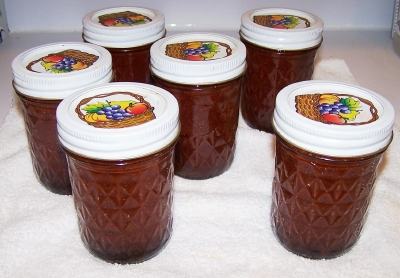 How to Make Super Easy Homemade Ketchup from Fresh Tomatoes - Easily!
How to Make Super Easy Homemade Ketchup from Fresh Tomatoes - Easily!
The super-easy version of homemade ketchup
Have you ever tried homemade ketchup? Did you know it tastes like TOMATOES??? Real ketchup (or catsup) is easy to make following this simple blender recipe - and all natural! You can even make it without added sugar or use Honey or Stevia (in a prepared form like Truvia, it measures same as sugar; if you use another form, you will need do your own conversion) - or Splenda, if you prefer, instead - so whether you want to eliminate sugars for diabetic needs, calorie counting or want a natural homemade ketchup - this recipe is for you. Use Organic tomatoes, peppers and onions and make your own natural, organic ketchup!
We take ketchup (or catsup, if you prefer) for granted - it is everywhere and Americans use it in almost everything. Some even put it on scrambled eggs. So maybe you wondered if homemade ketchup taste any different or better? And if you have a mountain of homegrown tomatoes that are going to waste, here's your chance to make your own ketchup and customize to your own taste! Need a low-salt diet? Skip the salt! Want a spicy ketchup? Add some Tabasco or chilies. Making and canning your own ketchup is something families remember years later. No store bought ketchup compares with the taste of that made from your own tomatoes from your garden or fresh-picked from a local farm! In the middle of the winter, you can pour the ketchup on your food and taste the summer flavor of fresh tomatoes.
Here's how to do it, in easy steps and completely illustrated. This method is easy, ANYONE can do this; and is NOT time consuming - the tricks I've found are illustrated below - using a blender and a crockpot takes all the work and time out of it! It's a great thing to do with your kids!
You may also be interested in How to make cucumber pickle relish! This is the classic hamburger relish!
Ingredients
Yield: About 5 or 6 pints
- 12 lbs ripe tomatoes
- 1 lbs onions
- 1/2 lb sweet red peppers
- 1/2 lb sweet green peppers
- 4.5 cups vinegar (5 percent)
- 4.5 cups sugar OR Stevia (in a prepared form like Truvia, it measures same as sugar; if you use another form, you will need do your own conversion) - or Splenda, if you prefer, OR any combination of the two... OR no sweetener at all, if that's what you like.
- 1/8 cup canning or pickling salt (again optional - if you are on a salt-restricted diet, you can omit this, it is not used as a preservative in this recipe)
- Spice bag or cheesecloth
- Spices (version 1)
- 1 tablespoon dry mustard
- 1/2 tablespoon ground red pepper
- 1/2 teaspoon whole allspice
- 1/2 tablespoon whole cloves
- 1 stick cinnamon (3 inches long)
- Spices (version 2)
- 1 tablespoon dry mustard
- 1/2 tablespoon ground red pepper
- 1/4 teaspoon ground allspice
- 1/2 tablespoon ground cloves
- 1/4 teaspoon ground cinnamon
Equipment
- 1 blender - I purchased mine in 1976 (note the "harvest gold") for $20 and it is still going strong, so at less than 70 cents per year, it's worth it!
- 1 crock pot - You can make it without one, and if you feel like standing there stirring for hours, be my guest. I can think of .at least 5,676 other things I'd rather be doing.
- 1 water bath canner (a huge pot to sanitize the jars after filling (about $30 to $35 - $30 at mall kitchen stores and local "big box" stores. Note: we sell many sizes and types of canners for all types of stoves and needs through our reliable suppliers - see canning supplies Tomatoes are on the border between the high-acid fruits that can be preserved in a boiling-water bath and the low-acid fruits, vegetables and meats that need pressure canning. I have a pressure canner, so I use that just to make sure there's less spoilage, but a water bath canner,will work.
- Food mill or sieve - Not required but it makes a nice, fast polishing step to remove any seeds and hard bits. Plus, you can use it to make applesauce, seedless jam and more.I highly recommend the Foley Food Mill - it's only about $25. You can use an ordinary sieve, but it will take much longer.
- Pint or half-pint canning jars (Ball or Kerr jars can be found at Publix, Kroger, Safeway and local "big box" stores - about $13 per dozen 8-ounce jars, more for quilted design or larger jars, including the lids and rings).
- Lids - thin, flat, round metal lids with a gum binder that seals them against the top of the jar. They may only be used once.
- Rings - metal bands that secure the lids to the jars. They may be reused many times.
- Jar grabber (to pick up the hot jars)
- Lid lifter (has a magnet to pick the lids out of the almost-boiling water where you sanitize them. ($4 at mall kitchen stores and local "big box" stores, but it's usually cheaper online from our affiliates)
- 1 large pot.
- Large spoons and ladles,
- Jar funnel ($3-Grocery stores, like Publix, Kroger and Safeway and local "big box" stores; sometimes even hardware stores)
Process - How to Make Ketchup (or Catsup) from Fresh Tomatoes
Step 1 - Selecting the tomatoes
It's
fun to go pick your own and you can obviously get better quality
tomatoes!
At right is a picture of tomatoes from my garden - they are so much better than anything from the grocery store. And if you don't have enough, a pick-your-own farm is the pace to go! Below are 4 common varieties that will work:
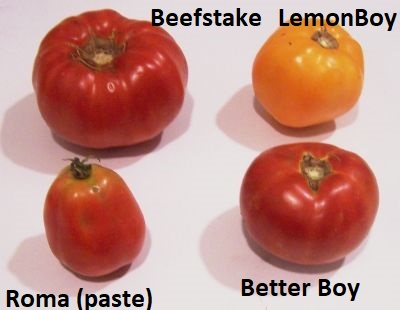
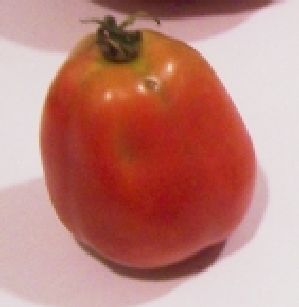 The
picture at left shows the best variety of tomato to use: Roma; also called
paste tomatoes. they have fewer sides, thicker, meatier walls, and
less water.
The
picture at left shows the best variety of tomato to use: Roma; also called
paste tomatoes. they have fewer sides, thicker, meatier walls, and
less water.
Also, you don't want mushy, bruised or rotten tomatoes!
Step 2 - Removing the tomato skins
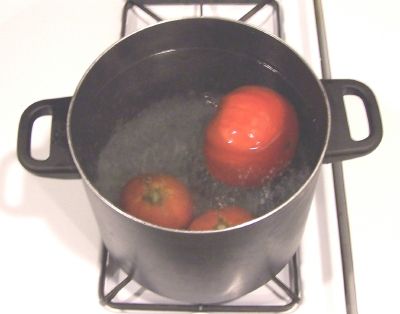 Here's
a trick you may not know: put the tomatoes, a few at a time in a large pot
of boiling water for no more than 1 minute (30 - 45 seconds is usually
enough)
Here's
a trick you may not know: put the tomatoes, a few at a time in a large pot
of boiling water for no more than 1 minute (30 - 45 seconds is usually
enough)
then....
Plunge them into a waiting bowl of ice water.
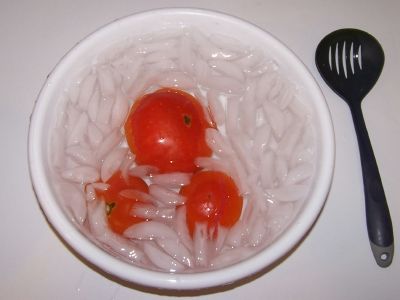
This makes the skins slide right off of the tomatoes! If you leave the skins in, they become tough and chewy in the sauce, not very pleasant.
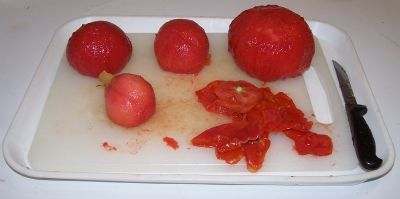 Step
3 - Removing seeds and water
Step
3 - Removing seeds and water
After you have peeled the skins off the tomatoes, cut the tomatoes in half. Now we need to remove the seeds and excess water. You don't HAVE to, but if you don't remove the free water, it will take longer to cook it down. Most people prefer to remove most of the seeds, but, again, you don't need to.
 Just
like it sounds: wash your hands then squeeze each tomato and use your
finger or a spoon to scoop and shake out most of the seeds. You
don't need to get fanatical about it; removing just most
will
do.
Just
like it sounds: wash your hands then squeeze each tomato and use your
finger or a spoon to scoop and shake out most of the seeds. You
don't need to get fanatical about it; removing just most
will
do.

Step 4 - Drain the tomatoes
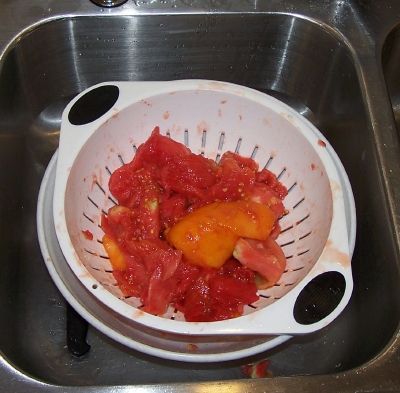 Toss
the squeezed (Squozen? :) tomatoes into a colander or drainer, while you
work on others. This helps more of the water to drain off. You may
want to save the liquid: if you then pass it through a sieve, screen or
cheesecloth, you have fresh tomato juice; great to drink cold or use in
cooking!
Toss
the squeezed (Squozen? :) tomatoes into a colander or drainer, while you
work on others. This helps more of the water to drain off. You may
want to save the liquid: if you then pass it through a sieve, screen or
cheesecloth, you have fresh tomato juice; great to drink cold or use in
cooking!
Step 5 - Prepare the peppers and onion
Remove
seeds from peppers and slice into strips. Peel and quarter onions.
Step 6 - Start blending them, in 5 second batches
Blend tomatoes, peppers, and onions at high speed for 5 seconds in electric blender.
It will take a number of blenders-full to work your way through all the tomatoes, peppers and onions.
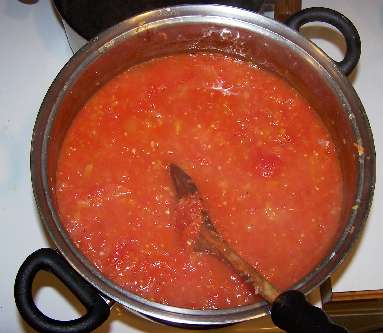
Step 7 - Heat to a boil
Just heat the tomato-peppers-onions mix to a boil,
And then simmer the tomatoes for about 1 hour over medium-low heat.
Step 8 - Add the seasonings and vinegar and cook down to thicken the mix
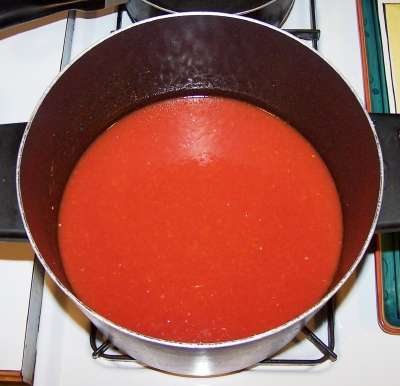 Now
it's time to add the
Now
it's time to add the
- 4.5 cups vinegar (5 percent)
- 4.5 cups sugar OR Stevia (in a prepared form like Truvia, it measures same as sugar; if you use another form, you will need do your own conversion) - or Splenda, if you prefer, OR any combination of the two... OR no sweetener at all, if that's what you like.
- 1/8 cup canning or pickling salt (again optional - if you are on a salt-restricted diet, you can omit this, it is not used as a preservative in this recipe)
And add one of the two spice options -
- Spices (version 1) - tie these in a spice bag or cheesecloth
- 1 tablespoon dry mustard
- 1/2 tablespoon ground red pepper
- 1/2 teaspoon whole allspice
- 1/2 tablespoon whole cloves
- 1 stick cinnamon (3 inches long)
OR
- Spices (version 2), added directly, not in a bag
- 1 tablespoon dry mustard
- 1/2 tablespoon ground red pepper
- 1/4 teaspoon ground allspice
- 1/2 tablespoon ground cloves
- 1/4 teaspoon ground cinnamon
Continue cooking on low heat in the crockpot (OR standing over it, boiling and stirring ) until volume is reduced one-half and ketchup rounds up on a spoon with no separation of liquid and solids.
I find it takes about 12 hours, but each crockpot may vary. You want it to get as thick as you like your ketchup, remembering that it will also thicken a little bit after you cool it. The photo doesn't show it, but I cover with a splatter screen or the lid on loosely (so the steam can escape)
Step 9 - Get the jars and lids sanitizing
 The
dishwasher is fine for the jars; especially if it has a "sanitize" cycle.
I get that going about 30 minutes before I figure the ketchup has cooked
down enough (yes, that's a bit vague!)
The
dishwasher is fine for the jars; especially if it has a "sanitize" cycle.
I get that going about 30 minutes before I figure the ketchup has cooked
down enough (yes, that's a bit vague!)
Be sure to let it go through the rinse cycle to get rid of any soap! It's also a good time to start heating up the water in the canner and the small pan of water to warm the lids to soften the adhesive.
Lids: Put the very hot (but not quite boiling; around 180 F,
steaming water is fine)
water for at least several minutes.
Note: everything gets sanitized in the water bath (step 12), so this just helps to ensure there is no spoilage later!)
Step 10 - Fill the jars with the ketchup and put the lid and rings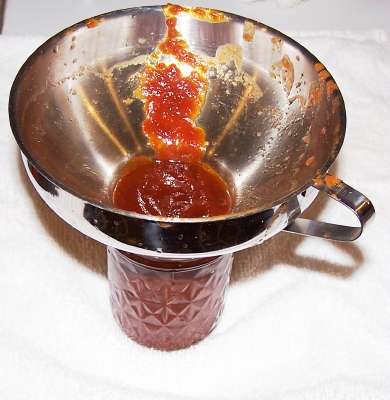 on
on
Fill them to within 1/4-inch of the top, seat the lid and hand-tighten the ring around them.
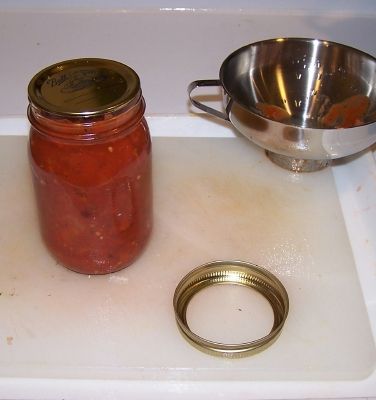 Be
sure the contact surfaces (top of the jar and underside of the ring) are
clean to get a good seal!
Be
sure the contact surfaces (top of the jar and underside of the ring) are
clean to get a good seal!
Step 11 - Process (boil) the jars in the canner
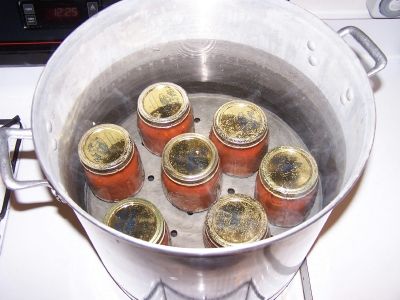 Put
them in the canner and keep them covered with at least 1 inch of water.
Keep the water boiling. Process the jars in a boiling-water bath for 15
minutes for half-pints and pints. Remember to adjust the time if you are
at a different altitude other than sea level!
Put
them in the canner and keep them covered with at least 1 inch of water.
Keep the water boiling. Process the jars in a boiling-water bath for 15
minutes for half-pints and pints. Remember to adjust the time if you are
at a different altitude other than sea level! 
If you have a Pressure Canner, and want to use that, be sure to follow their directions.
| Recommended process time for Blender Ketchup in a boiling-water canner. | |||
| Process Time at Altitudes of | |||
| Jar Size | 0 - 1,000 ft | 1,001 - 6,000 ft | Above 6,000 ft |
| Half pints or Pints | 15 min | 20 | 25 |
Step 12 - Done
 Lift
the jars out of the water and let them cool without touching or bumping
them in a draft-free place (usually takes overnight) You can then
remove the rings if you like, but if you leave them on, at least loosen
them quite a bit, so they don't rust in place due to trapped moisture.
Once the jars are cool, you can check that they are sealed verifying that
the lid has been sucked down. Just press in the center, gently, with your
finger. If it pops up and down (often making a popping sound), it is not
sealed. If you put the jar in the refrigerator right away, you can still
use it. Some people replace the lid and reprocess the jar, then that's a
bit iffy. If you heat the contents back up, re-jar them (with a new lid)
and the full time in the canner, it's usually ok.
Lift
the jars out of the water and let them cool without touching or bumping
them in a draft-free place (usually takes overnight) You can then
remove the rings if you like, but if you leave them on, at least loosen
them quite a bit, so they don't rust in place due to trapped moisture.
Once the jars are cool, you can check that they are sealed verifying that
the lid has been sucked down. Just press in the center, gently, with your
finger. If it pops up and down (often making a popping sound), it is not
sealed. If you put the jar in the refrigerator right away, you can still
use it. Some people replace the lid and reprocess the jar, then that's a
bit iffy. If you heat the contents back up, re-jar them (with a new lid)
and the full time in the canner, it's usually ok.
Other Equipment:
 From
left to right:
From
left to right:
- Jar lifting tongs
to pick up hot jars - Lid lifter
- to remove lids from the pot
of boiling water (sterilizing ) - Lids
- disposable - you may only
use them once - Ring
- holds the lids on the jar until after
the jars cool - then you remove them, save them and reuse them - Canning Jar funnel
- to fill the jars
Summary - Cost of Making Homemade Ketchup - makes 7 - 8 oz jars* |
||||
| Item | Quantity | Cost in 2025 | Source | Subtotal |
| Tomatoes | 12 lbs (to make about 8 cups of prepared tomato) | free from the garden, or $0.75/lb at a PYO | Garden , farm, market | $0.00 |
| Onions | 1 lb | free from the garden, or $0.75/lb at a PYO | Garden, farm, market | $0.50 |
| Peppers | 1 lb | free from the garden, or $0.75/lb at a PYO | Garden, farm, market | $0.50 |
| Sugar | 3 cups | $2.00 | $2.00 | |
| Vinegar (5%) white | 4.5 cups | $1.00 (in a large jug) | grocery store | $1.00 |
| Canning jars (8 oz size, wide mouth), includes lids and rings | 7 jars | $8.00/dozen | Grocery stores, like Publix, Kroger and Safeway and local "big box" stores; sometimes Big Lots and even hardware stores | $5.00 |
| seasoning | See step 7 | $1.00? assuming you already have them. just the fraction you will use. | Grocery stores, like Publix, Kroger and Safeway and local "big box" stores | $1.00 |
| Total | $11 total or about $1.57 per 8 oz jar INCLUDING the jars - which you can reuse! If you already have the jars, you need only buy new lids, so the cost becomes about 75 cents per cup! |
|||
|
* - This assumes you already have the pots, pans, ladles,, and reusable equipment. Note that you can reuse the jars! |
||||
Answers to Common Ketchup Making / Canning Questions
What did I do wrong if my jars spoil?
Tomatoes are a borderline acid / low acid fruit (see this page about tomato acidity for more information) - adding lemon juice helps, processing at least 35 minutes in the water bath canner, or better still, using a Pressure Canner almost eliminates spoilage. If you don't have a pressure canner, you must boost the acid level of the sauce, by adding 2 tablespoons of lemon juice or 1/2 teaspoon of citric acid per quart of sauce.
Larger jars? Comments from a visitor on September 24, 2013: "I love your website and have used it for many canning projects. I do have a question. I am interested in making ketchup. We have a family of seven, so canning in pints seems impractical. If I use quarts, how much time would I need to process them for? My elevation is 3,000 - 6,000 ft. Also, as it is more practical to can most things in quarts, is there a standard amount of minutes I could increase to any canning recipe that calls for pints? Thanks!"
Well, that's the problem no lab, university or authority has actually tested it in larger containers, so you will be conducting your own tests on your family. That's not to say, it can't be canned safely in larger jars, just that we don't know the parameters because no food scientist has tested it.
Until they develop reliable lab test data, I wouldn't go larger than a pint jar.
Looking for canning equipment and supplies?
Water bath canner with a jar rack
Pressure canners for gas, electric and induction stoves: Presto 23Qt or T-fal 22Qt
Canning scoop (this one is PERFECT)
Ball Blue book (most recent version)
Jars: 8oz canning jars for jams
Find Other types of farms:
Farm markets and roadside stands
Road trips and camping resources
Local Honey, apiaries, beekeepers
Consumer fraud and scams information
Home canning supplies at the best prices on the internet!
Maple Syrup Farms, sugarworks, maple syrup festivals
Environmental information and resources
Farms For Your Event for birthday parties, weddings, receptions, business meetings, retreats, etc.
Festivals - local fruit and vegetable festivals
Get the
most recent version of
the Ball Blue Book
With this Presto 23 quart pressure canner and pressure cooker, you can "can" everything, fruits, vegetables, jams, jellies, salsa, applesauce, pickles, even meats, soups, stews. Model 01781

You can make jams, jellies, can fruit, applesauce, salsa and pickles with water bath canners, like this Granite Ware 12-Piece Canner Kit, Jar Rack, Blancher, Colander and 5 piece Canning Tool Set

